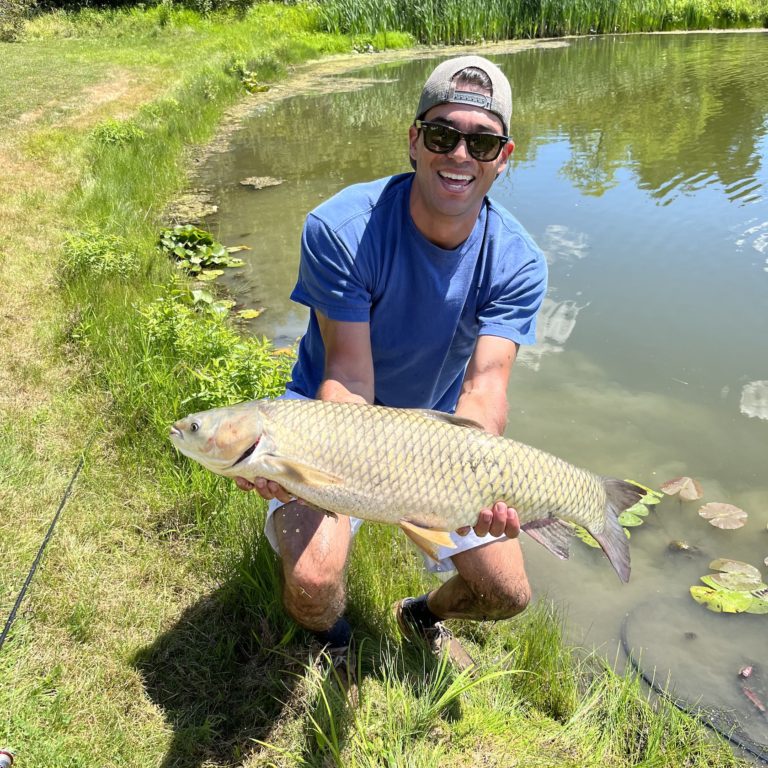The Grass carp

The grass carp (Ctenopharyngodon Idella) is a warm-water fish found across western New York. Grass carp typically range between 25 and 40 inches in length and can be identified by their dull gold/olive body, large scales, and forward-set eyes. Grass carp are easily distinguished from common carp by their lack of barbels, relatively narrow body, and lack of sucker-like mouth. Grass carp are actually members of the minnow family, and, as you would probably guess, are the largest members of the family.
Grass carp are native to Asia and were introduced into the United States primarily for vegetation control. Grass carp are stocked as sterile triploids that unable to reproduce. Because they are herbivores, grass carp don’t require a forage base and can reach immense sizes in small bodies of water as long as there is sufficient aquatic vegetation to sustain them. If you ever find yourself at a neighborhood pond and spot a few fish that far outsize the rest (sometimes by feet!), they’re most likely grass carp.
Habitat
Like common carp, grass carp are warm-water fish and are very tolerant of high temperatures, well in excess of 70 F. Grass carp thrive in environments with plenty of aquatic vegetation, which is their primary food source. Grass carp are found almost exclusively in ponds or small lakes where they have been stocked for vegetation control.
In ponds and lakes, grass carp can be found pretty much anywhere but can often be seen snacking on weeds close to shore. Grass carp also sometimes hang out near the surface, rising to eat insects or berries or grab floating globs weeds that drift by.
Food
Grass carp are herbivores and feed primarily on aquatic vegetation although they will sometimes eat bugs that fall onto the surface of the water. Grass carp often bite and rip off chunks of weed bed or floating vegetation when feeding. Unlike common carp, grass carp don’t typically scavenge the bottom but instead feed primarily in the upper part of the water column. Grass carp can sometimes be seen rising in a manner similar to trout, although with much less haste.
Where to Catch Grass Carp
Grass carp are common across western New York and can probably be found in all counties. Unlike other fish of western New York, however, grass carp are only found in lakes and ponds in which they have been stocked. Therefore, the best place to find grass carp is in neighborhood ponds or municipal lakes. Grass carp will not be found in major bodies of water such as Lake Erie, Lake Chautauqua, etc. in appreciable numbers. Self-sustaining populations of grass carp should be nonexistent in western New York per regulations permitting only sterile triploids.
Spring and summer are the best times for targeting grass carp as they are most active during warm weather. Grass carp provide an exciting angling opportunity during the dog days of summer, when fishing for other species has slowed considerably. A good strategy for finding grass carp is to walk the perimeter of a pond with polarized glasses. First, you should look to see if you can spot any carp hanging out near the surface of the water or if you can spot any carp rising. Second, you should look for carp cruising along the weed edges grabbing mouthfuls of vegetation. Third, a telltale sign of grass carp is witnessing a very large boil of water as you walk the shoreline; this boil is from a grass carp or multiple grass carp that have been spooked and moved a large amount of water as they fled. The boil created by a fleeing grass carp is unmistakably big compared to that of a fleeing bass or bluegill.
How to Catch Grass Carp
Because of their diet and feeding habits, the best way to target grass carp is with bait. Good baits for grass carp include anything edible that floats such as bread, dog food, berries, tomatoes, etc. When using bread for bait, take about ¼ to ½ slice and mash it onto your hook to form a sort of pancake. When using dog food, make sure that the pieces you choose float and thread a piece or two through your hook to above the eye of the hook (so the hook is dangling just beneath the kibble).
There are two tricky parts about grass carp fishing. The first tricky part is keeping your bait on the hook. Bread will usually fall off after a cast or two or even fall of while soaking in the water, while dog food usually allows around three to four casts before falling off. Therefore, you should plan on bringing plenty of bait with you when heading out to fish grass carp.
The second tricky part about grass carp fishing is not spooking the fish. Grass carp are incredibly spooky and often flee if they see you or sense vibrations in the water (i.e. line or bait hitting the water). It is most productive to sight fish grass carp, but you need to maintain a low profile and cast carefully. It is oftentimes helpful to lead the fish with your bait (i.e. understand the direction and speed that the fish is traveling and cast ahead of it to avoid spooking it).
